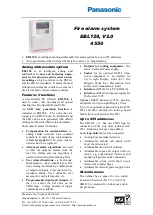
DS240/DS241 Installation Instructions
© 2004 Bosch
P/N: 22066P Page 5
- If the LED is off, check for the presence of power and proper
polarity on Terminals 1 (–) & 2 (+).
- A steady green LED indicates a faulty transmitter, and the unit
should be returned to the factory.
• Check the three receiver LEDs (see
Figure 9).
Red/Alarm
Trouble/Yellow
Green/Normal
Figure 9 - Receiver's LEDs
- It is normal for all of them to be on at this time, with the green
indicator either flashing or constantly on.
- If all are off, check for the presence of power and proper
polarity on Terminals 8 (–) & 9 (+).
• Mount an AL240 strobe aiming light or equivalent (such as a
Faraday 5508) as close to the receiver as possible (preferably on
top of the receiver).
- Point it at the transmitter as your guide for aiming (an aiming
light may not be necessary for short distance separations).
7.1 Preliminary Alignment
Each optical module is equipped with two alignment mirrors (one on
each side) for initial alignment (see
Figure 10).
To initially align an optical module, look into either mirror from a side
angle at least 2 ft (61 cm) from the module. The optical module is
pointed at objects seen in the mirror when the orange colored front
bore sight is in the center of the rear bore sights (see
Figure 11).
Rear Bore Sights
Front Bore Sight
Figure 11 - View of the Alignment Mirror
with Bore Sights Aligned Properly.
HINT: Use alignment sights like aiming a gun.
• Rotate the transmitter's optical module left or right until the
image of the aiming light (or receiver image, if aiming light is not
used) can be seen in the mirror.
- If initially aimed too high or low, adjust the Vertical Fine Tuning
adjustment allen screw (with supplied allen wrench) slightly
up or down until the image is found.
• Use the Vertical Fine Tuning adjustment screw and the
Horizontal Fine Tuning adjustment screw to fine tune the image
to the center of the mirror (in-line with the front and rear bore
sights).
• Replace and secure the transmitter's cover when this alignment
procedure is complete.
• Check the transmitter's green LED. It should be flashing.
• Replace and secure the transmitter's access door.
• Align the receiver to the image of the transmitter using the above
preliminary alignment procedure.
• Check the receiver's green LED. It should be flashing. This
indicates that the preliminary alignment is complete.
- If the receiver’s green LED is not flashing, repeat the prelimi-
nary alignment procedure for the receiver.
7.2 Sensitivity Adjustment
Use the chart below (
Figure 12) to aid in the sensitivity adjustment.
Figure 12 - Recommended Settings Chart
NOTE: Positions 8 and 9 are not valid positions. They are not to be
used.
• Select the appropriate sensitivity setting from the above chart
based on the distance between the transmitter and receiver.
• Set the receiver’s Sensitivity switch at this setting.
• The Sensitivity switch is located just to the right of the optical
module on the receiver. The indicator or pointer marking runs
along the side of the switches' shaft (see
Figure 13).
0
Figure 13 - Sensitivity Switch
• The recommended settings chart lists distances with some
settings that overlap. For more sensitive detection, select the
lower number setting. For better immunity to false alarms, select
the higher number setting.
FRONT VIEW
HORIZONTAL
FINE TUNE
VERTICAL
FINE TUNE
ALIGNMENT
MIRRORS
SIDE VIEW
ALIGNMENT
MIRROR
REAR BORE SIGHTS
FRONT BORE SIGHT
Figure 10 - The Optical Module
s
g
n
i
t
t
e
S
d
e
d
n
e
m
m
o
c
e
R
h
c
t
i
w
S
g
n
i
t
t
e
S
y
t
i
v
i
t
i
s
n
e
S
m
r
a
l
A
e
s
n
o
p
s
e
R
h
t
g
n
e
L
m
a
e
B
0
%
0
3
c
e
s
5
)
m
1
3
-
9
(
t
f
0
0
1
-
0
3
1
%
0
6
c
e
s
5
)
m
7
0
1
-
1
3
.
t
f
0
5
3
-
0
0
1
2
%
0
2
c
e
s
0
3
)
m
5
1
-
9
(
t
f
0
5
-
0
3
3
%
0
3
c
e
s
0
3
)
m
3
2
-
4
1
.
t
f
5
7
-
5
4
4
%
0
4
c
e
s
0
3
)
m
1
3
-
1
2
(
t
f
0
0
1
-
0
7
5
%
0
5
c
e
s
0
3
)
m
3
4
-
7
2
.
t
f
0
4
1
-
0
9
6
%
0
6
c
e
s
0
3
)
m
5
5
-
7
3
(
t
f
0
8
1
-
0
2
1
7
%
0
7
c
e
s
0
3
)
m
7
0
1
-
9
4
(
t
f
0
5
3
-
0
6
1






























